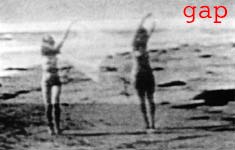
Tim Hungerford

Tim Hungerford
Even the most perfect reproduction of a work of art is lacking in one element: its presence in time and space, its unique existence at the place where it happens to be.
Walter Benjamin, Illuminations... and the things you can't remember tell the things you can't forget
that history puts a saint in every dream ...
and Matilda asks the sailors are those dreams or are those prayers ...
Tom Waits, 'Time' from Rain Dogs
Walter Benjamin's often repeated thesis has proved to be seminal in the debate surrounding the issue of reproduction, especially that of photography. The question I want to pose here, is how to speak of this lack (want, failure, lapse). Benjamin, touches upon, speaks of 'lack' by coupling 'time and space'. A yearning or nostalgia. Pothos ... that (absence) which incites, provokes, and compels.(1) In terms of a desire-making machine, as a counter-effect of desire, as plenitude, exercise, and functioning.(2) If 'lack' is associated with exclusion or absence (void) something other must take its place, reading between the lines, off-frame.
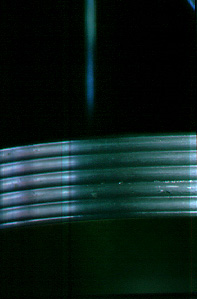
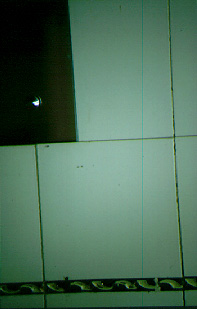
A gap in time. The interval between a cup just touching the chequered linoleum floor and smashing to bits. A lapse of infinite time, a few seconds maybe; leaving traces, coffee stains.(3) That which resists (resilient), the barely there, the styleless. A significant Other. Lacking the obvious arrangements of harmony, scale, rhythm, structure, order. A minor event, of surfaces rather than depths. Misreading the gap. Touching the edge of the frame, speaking about the room next door or behind. Infiltrating and subverting language in the space between sense and nonsense, aesthetic and unaesthetic.(4)
... the photograph is pure contingency and it can be nothing else (it is always something that is represented) ...(5)
How can architectural photography be spoken of in terms of a minor literature? As an event of surfaces, not of depth or symbolism. By removing it from the 'major' institution (artistic, tourist, landscape, architectural) what would a minor (architectural) photography be if it is not intended to 'express', to 'represent', or to 'imitate'? How does it affect the language (photography) in which it is effected.(6) In comparison to the 'major' or 'dominant', that which predominates, bounds, brackets, binds. Recognised and understood in terms of composition, rhythm, scale, frame, light, dark, shadow and narrative (in the space of the architectural journal).
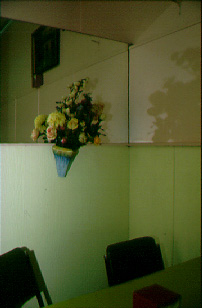
A minor photography contests completeness, asks more questions than gives answers, offers clues: fragmenting, substituting, corrupting. In this way architecture becomes incidental to photography. By photographing, framing fragments, by exclusion and ultimately displacing architecture. The question is not so much 'what' the photograph is; but rather, how the photograph is seen. In Camera Lucida, Roland Barthes acknowledges the punctum (poignancy, irreversible absence, displacement) as that aspect of the off-frame which the spectator brings to the photograph.(7)
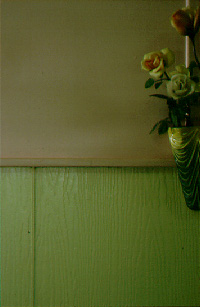
The camera undoubtedly contrives and manipulates (substitutes and fetishizes), as does the photographer (the Operator), to what end? The proliferation and use of mass media has given rise to an experience of architecture grounded not in the architectural object (as a temporal or sensory experience); but rather in the 'architectural supplement'. "... [T]his dematerialisation ultimately condemned architecture to a higher level of fetishization as it began to be framed by a new market that provided more powerful substitute exhibition and publication values."(8) This certainly has an untold impact on our relationship to architecture. It becomes a question of equivalence, of both/and.
To think about modern architecture must be to pass back and forth between the question of space [and time] and the question of representation. Indeed, it will be necessary to think of architecture as a system of representation, or rather as a series of overlapping systems of representation.(9)
It almost seems paradoxical to consider a 'minor architectural photography' as Other. As the minor certainly relates to our real typical, everyday, banal. A street sign is always in the way (there are certain to be hordes of tourists posing for their souvenir snapshot). Interiors are clumsy and cluttered, marked by our artefacts of unapproved taste "... sedimenting the past in the present".(10) Paint chips. Have you ever come across a colour photograph of the Villa Savoye? It just doesn¹t work. It doesn¹t satiate our desire for the high contrasts between light, dark, and shade. The profound figure/ground juxtaposition between architecture (white) and field (black) becomes lost in the infinite hues of a cibachrome print. Our desire is for that polarity, simplicity of understanding. Architecture resists dispersed attention.
... (do architectural photos ever include runners, fighters, lovers?)(11)
Beatriz Colomina's Privacy and Publicity: Modern Architecture as Mass Media, traces modern architectures engagement with other practices in, photography, film, publication and exhibitions arguing that "... architecture only becomes modern in its engagement with the mass media, and that in doing so it radically displaces the traditional sense of space and subjectivity".(12)
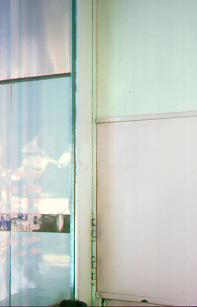
Le Corbusier quite systematically included his modern artefacts (derby hat, trademark black rimmed glasses, golf clubs, automobiles) in the photographs of his (modern) architecture, as if to exaggerate and lay claim to the modern. These were not just traces; they are read as a continual presence and possession maintained and asserted.(13) Neglecting here, supplanting there.(14) Here again the issue (confrontation) of closure erupts, or at least fails. Le Corbusier's territorialisation (pissing in the corners, mapping, misreading).
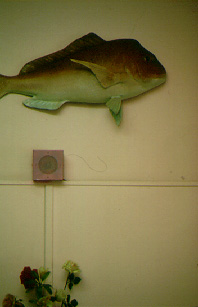
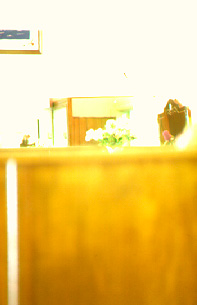
Venturi replaces Le Corbusier's automobile with his mother seated and centred in front of the facade. This substitution (oedipalization) announces more than the 'birth' of Venturi and postmodernism. The mother figure does not simply fill the void left by the car "... the Vanna Venturi house announces the theme of the mechanical extension of the body, a dangerous liaison between the 'machine-for-living and the body of the architect's mother."(15)
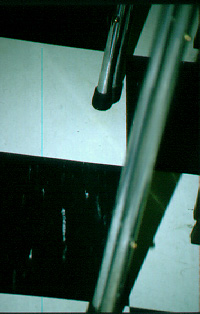
Both instances are significant for their cluttered and messy misreadings. For their desire to territorialise architecture via photography, placing it in the nursery, by fetishizing and oedipalizing it. Venturi and Corbusier impart another reading that is not minor but heroic, definitive, complete. Left for dead.
Ultimately or at the limit in order to see a photograph well, it is best to look away or close your eyes ... the photograph must be silent ... this is not a question of discretion, but of music.(16)
Here, Barthes speaks of another lack, the absence of sound; or rather, silence as music, as memory and punctum. Music, both literal and metaphorical, is what animates the photograph, what allows one to animate it, to enter the frame. Only when one is not listening. Silence is ever more apparent for its 'quality' of absence. The 'what' (how) the spectator sees (hears) as distinct from what is 'presented'. The incomplete building(17), a discordant harmony, an awkward silence between lovers (fighters). Picnolepsy. Silence becomes that much more powerful in its 'lack' as it distracts and detracts from the 'what' is there. As generosity. Generosity in the sense that no prescribed orthodoxy is given, the spectator is left to chance. A gap between what you can't remember and what you can't forget.
The mouth kisses the mouth spits; no one mistakes the saliva of the first for the second.(18)
Sediment accumulates. Paint chips. Renders fail. Buildings deteriorate in time assuming a patina of stains, streaks and spalling, revealing their deficiencies and failures. "In the process of subtracting the 'finish' of a construction, the weathering adds the 'finish' of the environment."(19) Surfaces exposed to weathering become a surface of documentation, continually evolving, marking time. To this end the photograph exploits and reveals surfaces as an unending metamorphosis. Resilient surfaces are designed no stave off the inevitable through the use of composites, durable coatings, elastomeric sealants. But when similar technologies (linoleum, glazed tiles, latex paints, aluminium and chrome) are applied to interiors the resilience becomes something other, no longer is there need to resist weathering. These surfaces are not the planer, smooth, objective surfaces of 'white' hygienic architecture. The interiority and privacy of the space reflects ad infinitum. These surfaces mirror the gaze, arresting it (mine, the camera's) for only a moment. Chintzy decorative elements and applied polychromy become the subject of the architecture.
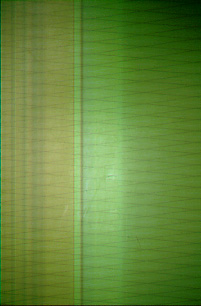
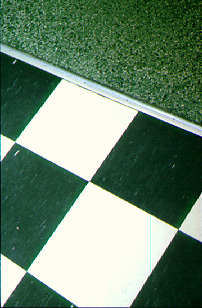
Notes
|
back |
links |
|
gap is Linda Marie Walker and Paul Hewson gap is designed and sponsored by Virtual Artists gap co-exists with parallel this page last modified 25 Nov 1995